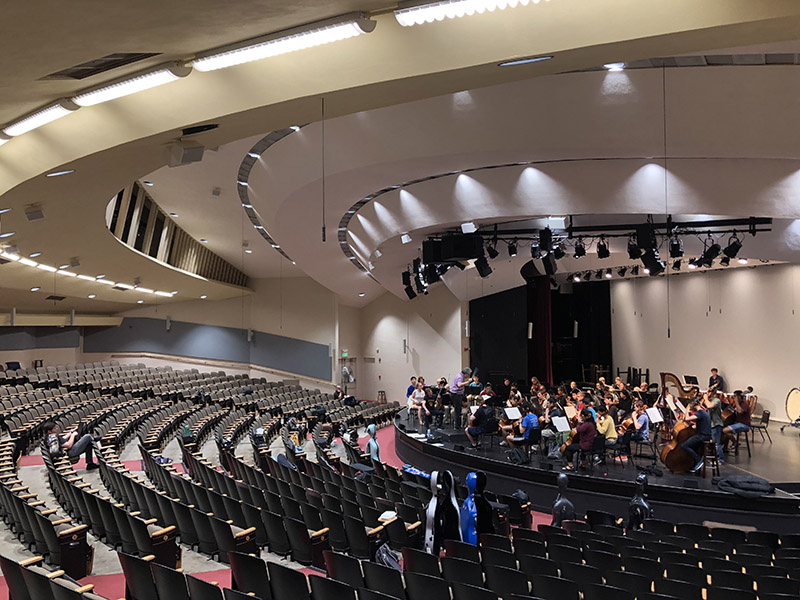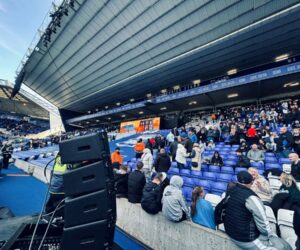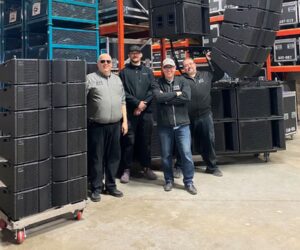Dinkelspiel Auditorium, a 710-seat performance and lecture hall on the campus of Stanford University in Palo Alto, CA, recently implemented a d&b audiotechnik Soundscape system to deliver on-stage reinforcement and another for in-seat listeners.
The venue tjat’s more commonly known as “The Dink” opened in 1959, with minimal upgrades to the sound and AV infrastructure over time dating back to the 1970s. That’s recently changed, however, with numerous upgrades put in place over the past five years.
“The process of updating the overall sound system began out of a need for the usable space that could be a reasonable replacement for ensembles performing in the Bing Concert Hall that opened in 2013,” states Kevin Sweetser, the audio consultant on the project. “The Bing had acoustics and aesthetics that were desired by many Department of Music groups. Dinkelspiel was old, and the acoustics were often described as backward with undesirable reflections. The added logistical concern was that Bing’s calendar was becoming increasingly packed and some ensembles would rehearse in the Dink until a couple of days prior to their concert in Bing.”
The audience Soundscape system provides the PA reinforcement for the room, delivering localization capability as well as reverberation enhancement as needed through the use of suspended stage and audience microphones, or direct inputs. The acoustic signature can be selected from among the seven currently available spaces, and the amount of enhancement can be controlled by the sound engineer on the mixing console. The stage mics can also be used to bring more energy off of the stage to the audience in acoustic performances. The d&b DS100 processor is enabled with both the En-Scene and En-Space modules to accomplish object positioning as well as reverberation enhancement.
“We learned about the d&b Soundscape system while investigating digital room acoustic systems,” Sweetser notes. “Soundscape was just being released and once we were able to hear a demo we realized the potential it had. Ultimately, we chose Soundscape and due to its flexibility and quality, from a sound perspective, the room acoustic models were fantastic and felt natural. Logistically, we were able to use one set of speakers for both the room acoustics and sound reinforcement. This particular design allowed us to reconfigure the distributed main PA used in Soundscape to a traditional LCR (left-center-right) line array so as to allow additional flexibility without the added cost of owning two separate sets of speaker systems.”
Sweetser adds that “a major bonus was that d&b helped facilitate a mutually beneficial effort to record the acoustic signature of the Bing Concert Hall for use in the Soundscape library, )which is) on its own a desirable room for acoustic music. We then were able to give students a rehearsal and performance space that was similar to that which they had become accustomed to using.” With this project, the Bing Concert Hall became the seventh available room emulation space available in the En-Scene add on.
The second Soundscape system resides in the stage area acting as a ‘virtual’ orchestra shell for musicians to rehearse and perform in a more comfortable acoustic environment like the Bing Concert Hall, and the DS100 processor is equipped with the En-Space plug-in to accomplish this. Again, use of the suspended stage mics creates the increased sense of ensemble, with an option to also bring the audience room mics into the system to enable a connection between the performers and the audience. The stage system is controlled by a simple touch screen interface to select the appropriate reverberation signature by non-technical staff members.
The two Soundscape systems were provided by Audio West (Los Angeles) and installed by Alive Media Audio Visual (Sacramento). “Alive worked extremely well with us to deploy and integrate our speaker design as well as new wiring infrastructure and acoustic treatment,” says Sweetser. “They were able to take our designs and instructions from Audio West and put them together seamlessly.”
The Soundscape systems can run at the same time or independently and were used throughout the summer season by the Stanford Jazz Festival. The main components of the system had been installed by the time Lee Brenkman came in to mix the Stanford Jazz Workshop’s students big band performances in early May. Brenkman has been mixing concerts for the Summer Jazz Festival for 25 years.
“Even though the acoustical treatment had not been installed and Soundscape not yet implemented, the improvement was considerable,” Brenkman says. “I was really looking forward to the beginning of the Stanford Jazz Festival at the end of June. I continued to get more familiar with the basic capabilities of the new speaker system, but it wasn’t until after an informative workshop on site with d&b’s Nick Malgieri that I really started getting into the capabilities of mixing using object-based positioning in Soundscape.
“I enjoyed the ability to position the sound sources on stage in their actual locations on stage in what the audience was hearing, and still not have those seated on the opposite side of the auditorium from, for example, the piano, ‘miss out’ on anything on stage. In the past, I’ve had to mix in big, distributed mono to ensure that all instruments were audible for everyone in the auditorium. With Soundscape I could achieve ‘depth’ and ‘spread’ on things like the 9- foot grand piano and drum kit and keeping them ‘in their place’ in the overall sound field. Nick assured me that object-based positioning was VERY intuitive and, indeed, it was.” Object-based mixing in Soundscape simplifies the job for the sound engineer using the R1 control software to easily place and move objects on screen in a user interface that is a direct correlation of the stage and audience area.”
A total of 101 d&b loudspeakers were installed between the two systems. The audience system consists of 14 T10 loudspeakers for mains, six 8S loudspeakers for front fills, sixteen 16C column loudspeakers for surround, two V-SUBS and two B22 SUBS, 26 5S loudspeakers used as overhead speakers, nine 10D and four 30D amplifiers, and three DS10 audio network bridges, and the DS100 signal engine with En-Space and En-Scene. The stage system that’s used as a virtual orchestra shell for musicians includes 18 5S loudspeakers, five 8S loudspeakers, a 18S-SUB, eleven 16C column loudspeakers, seven 10D amplifiers, two DS10 audio network bridges and another DS100 signal engine.




















